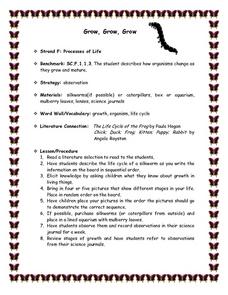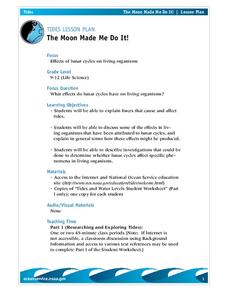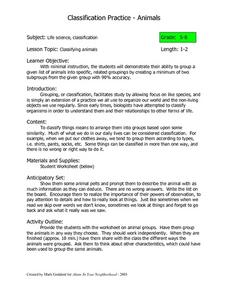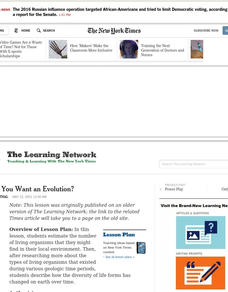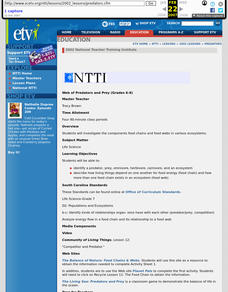Curated OER
Extra! Extra!
Students describe how plants and animals depend on each other. They see how living and nonliving environments change over time. They identify ways in which humans have changed their environment and the effects of those changes.
Curated OER
One Size Fits All?
Learners describe the differences between an estimate and a guess. They create reasonable estimates based on comparison and activities. Students explain how estimation is helpful in showing the relative size on a scale. They also...
Curated OER
Rock vs. Mineral - Lesson #1
Students describe visual, textural, and other physical qualities of sample rock specimens. Using compare and contrast skills, students sort and classify the specimens according to their assessments of the qualities present in each....
Curated OER
Catch a Rainbow
Second graders listen to a book read to them entitled, WHAT MAKES A RAINBOW and recall and describe their five senses and what parts of their bodies use their five senses and then complete the Catch a Rainbow activity sheet using a...
Curated OER
Grow, Grow, Grow
Students listen to literature selection, describe life cycle of silkworm, discuss what they know about growth in living things, observe silkworms for one week and record observations in science journals, and review stages of growth.
Curated OER
Photosynthesis
For this biology worksheet, students explain where the energy of food originally came from. Then the explain one of the principal chemical compounds that living things use to store energy. Students also describe how ATP and ADP differ...
Curated OER
What Is Life?
For this life characteristics worksheet, students answer 16 questions about living things, Redi's experiment, basic needs, growth and development.
Curated OER
BBC Learning English, Writing (E-mail)
In this ESL writing worksheet, students compare their own culture to that of England, then identify phrases used for comparing and contrasting. Students write an e-mail message describing some of these differences using the comparison...
Curated OER
The Moon Made Me Do It!
Students research about how lunar cycles affect living organisms. In this biology lesson, students prepare an oral presentation of their research results and analyses. They explore the forces that affect tides.
Curated OER
Classification Practice-Animals
Students use pictures of animals to make a classification system. In this classification lesson plan, students are given pictures of different animals. They create a classification system for the animals and identify what they have in...
Curated OER
The Classification of the Kingdoms of Life
Students can learn about the evolution of science by discussing the classification of living things.
Curated OER
You Say You Want an Evolution?
Students estimate the number of living organisms they might find in their local environment. After researching the types of organisms that existed during various geologic time periods, students describe how life forms have changed over...
Curated OER
Web of Predators and Prey
Students investigate the components food chains and food webs in various ecosystems. They describe how living things depend on one another for food energy (food chain) and how more than one food chain exists in an ecosystem
Curated OER
Marine & Aquatic Habitats Activities - Creatures in the Coral
Young scholars describe unique adaptations of organisms that live in the coral reef habitat, read various books pertaining to coral reefs and ocean life, and construct a wheel demonstrating the relationships between certain coral reef...
Curated OER
DIVISION OF LABOR
Students define division of labor. They read books about how things are produced to help illustrate the concept of division of labor. They suggest other items that could illustrate division of labor. They create a sample flow chart...
Curated OER
Endangered Species
Students watch video clips of endangered animals. They imagine a small garden in front of a house and describe the living and non-living things that could interact to make up a garden eco-system.
Curated OER
Electrophoresis Analogy
Students use and listen to analogies to help them become familiar with electrophoresis. One example is: Imagine a huge swimming pool full of water and many entangled nets (this is the agarose gel). A dump truck comes along and dumps...
Curated OER
Parts of an Ecosystem
Fourth graders study the Great Salt lake and the ecosystem that encompasses it. They study the relationship between an individual of a species, a population of that species, a community that includes that population, and the...
Curated OER
Roll of Thunder, Hear My Cry
Students watch the video Roll of Thunder, Hear My Cry. They participate in daily lecture, and create vocabulary cards. Students participate in oral reading evaluation, and complete a writing assignment:Do things like those that...
Curated OER
It Matters
Students use descriptive vocabulary to discuss the attributes of matter. Then, they sort objects or pictures by the type of matter they are comprised of. Finally, students match objects of matter with similar attributes and create a...
Curated OER
Making a Mini Worm Habitat
Students explore the process of converting organic waste into usable fertilizer. They observe how living and nonliving things interact with one another by making a mini-worm habitat.
Curated OER
Franklin Says "I Love You" Lesson Plan
Students listen to the story Franklin Says I Love You by Paulette Bourgeois in order to discuss the meaning of the story and to focus on the concepts of love, kindness, and giving. In this lesson on manners, students discuss Franklin's...
Curated OER
Testing for Life
Students test for organic molecules to determine if a solution contains once living molecules. In this characteristics of life lesson, students test common liquids for the presence of organic molecules, including starch, protein, and...
Curated OER
Getting to Know You
Students read a book about understanding differences. In this getting to know you lesson, students sit in a circle, roll a ball to each other and tell one thing about themselves when they get the ball. Students read the book...




